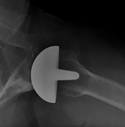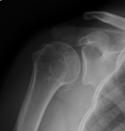The appeal of resurfacing as a treatment option for Osteoarthritis is that pain relief can be quite good, while avoiding the complexity and potential complications of replacing the glenoid as well. The pictures below are of the patient in the 1 year follow up video,which shows excellent function and pain relief. This case example reveals that hemiarthroplasty can provide good outcomes without necessarily having to resurface the glenoid. This may have particular appeal in younger patients whose activity level, sports avocations etc may place a glenoid component at risk for loosening. Historically hemiarthroplasty implants were only stemmed, but this device effectively removes a number of technical variables that must be addressed with a stemmed implant----which requires removal of the old head (humeral head osteotomy) such as offset, version, and inclination. With a resurfacing device, the native head is simply "capped."




For most cases of shoulder osteoarthritis, however, even in younger patients, total shoulder replacement is increasingly selected because pain relief may be more reliable. Newer implants are "anatomic" which enable precise restoration of version, inclination and offset. Additionally, glenoid fixation has evolved so much that concern about wear or loosening has diminished more recently. Nonethelss, resurfacing is an option, especially in cases where glenoid wear is minimal.
Avascular necrosis is a distinct diagnosis from osteoarthritis in which the glenoid is typically uninvolved, and for which humeral disease can be minimal---visible on mri only. Nonetheless, avn can cause tremendous pain and functional disability. In these cases, resurfacing is an excellent option as seen in the following pictures and the 2 year outcome video below.








For most cases of shoulder osteoarthritis, however, even in younger patients, total shoulder replacement is increasingly selected because pain relief may be more reliable. Newer implants are "anatomic" which enable precise restoration of version, inclination and offset. Additionally, glenoid fixation has evolved so much that concern about wear or loosening has diminished more recently. Nonethelss, resurfacing is an option, especially in cases where glenoid wear is minimal.
Avascular necrosis is a distinct diagnosis from osteoarthritis in which the glenoid is typically uninvolved, and for which humeral disease can be minimal---visible on mri only. Nonetheless, avn can cause tremendous pain and functional disability. In these cases, resurfacing is an excellent option as seen in the following pictures and the 2 year outcome video below.






